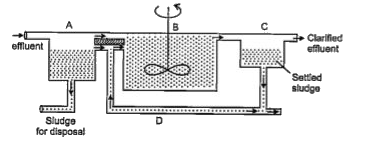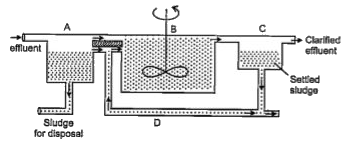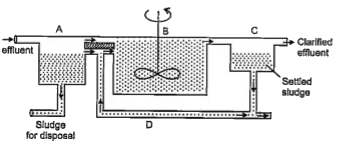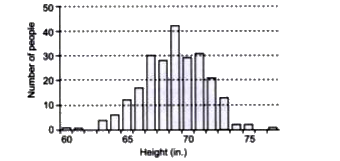Complete Solutions to QUESTIONS of chapter SAMPLE PAPER - 4 (BIOLOGY) of Class 12 book with complete answers and questions
| Class 12 | BIOLOGY |
| Chapter | SAMPLE PAPER - 4 (BIOLOGY) |
| OSWAL GURUKUL | QUESTIONS |
| Number Of Questions | 70 |
| Academic Year | 2023-24 |
What is phase when the organism is old enough to reproduce known as?
View SolutionSexual reproduction in flowering plants was discovered by
View SolutionWhat should be the phenotype of the `F_(1)` progeny produced by a cross between tall and dwarf true-breeding garden pea plants?
View SolutionClitoris in females is
View SolutionWings of bat and bird are
View SolutionCoacervates were experimentally produced by -
View SolutionYeast is used in the production of-
View SolutionWhat is the most important event in sexual reproduction?
View SolutionIn which of the following highest number of chromosomes found?
View SolutionAnalogous organs arise due to -
View SolutionThe permissible use of the technique amniocentesis is for
View SolutionCorpus luteum secretes-
View SolutionThe unit of natural selection is -
View SolutionThe first genetic material is -
View SolutionSynergids are -
View SolutionIn the absence of acrosome, the sperm -
View SolutionWhich of the following genotypes show the heterozygous condition?
View SolutionEpidermis, endothecium, middle layers, tapetum are:
View SolutionWhich one of the following is the most widely accepted method of contraception in India at present?
View SolutionThe sugar present in milk is-
View SolutionIdentify the odd from the following-
View SolutionGenotypic ratio of a monohybrid cross is -
View SolutionMeiosis occurs in -
View SolutionTheory of spontaneous generation was proposed by
View SolutionAbiogenesis occurred about ____billion years ago.
View SolutionChromosomal basis of inheritance was established by -
View SolutionMethanogens do not produce-
View SolutionIn angiosperms ______lead to the formation of a mature male gametophyte from a pollen mother cell.
View SolutionThe word gene for Mendelian factor was introduced by_____ in 1909.
View Solution_____comprises the egg apparatus.
View SolutionWhat is each copy of the duplicated chromosome called?
View Solution_____is the phenomenon wherein, the ovary develops into a fruit without fertilisation.
View Solution______carried out experiments to study linkage in Drosophila.
View SolutionLarger nucleus in a pollen grain is called_____.
View SolutionWhich one is the correct statement amongst the following?
View SolutionDiaphragms are contraceptive device used by females. Which one is the correct option from the statement given below?
(i) They are introduced into the uterus.
(ii) They are placed to cover the cervical region.
(iii) They act as physical barrier for sperm entry.
(iv) They act as spermicidal agents.
View SolutionMatch the following and choose the correct options:

View SolutionMatch the contraceptive methods given under column I with their examples given under column II and select the correct option.

View SolutionIdentify the odd one.
View SolutionFind the odd one out.
View SolutionAssertion: Gynoecium consists of pistil.
Reason : It represents the male reproductive part in flowering plants.
View SolutionAssertion : Corpus luteum is produced by Graafian follicle after ovulation.
Reason It secretes oestrogen which is necessary to maintain pregnancy.
View SolutionAssertion: A person should be considered reproductively healthy if he or she has healthy reproductive organs but is emotionally imbalanced.
Reason This statement about reproductive health was not given by the WHO.
View SolutionAssertion : Test cross is the cross between the `F_(1)` progeny and either of the parent types. Reason Back cross is the cross between `F_(1)` progeny and one of its parent plants.
View SolutionAssertion : Nuclear endosperm is formed by subsequent nuclear division without wall formation.
Reason : Coconut is an example of such endosperm where the endosperm remains nuclear throughout the development of the fruit.
View SolutionStudy the diagram given below and answer the questions that follow: An assignment on sewage treatment plant (STP) to study the microbial load. It was assigned to Saurin, a M.Sc. Student. He made of simplified figure of the STP for his project after visiting such plant in his locality.

A denotes:
View SolutionStudy the diagram given below and answer the questions that follow: An assignment on sewage treatment plant (STP) to study the microbial load. It was assigned to Saurin, a M.Sc. Student. He made of simplified figure of the STP for his project after visiting such plant in his locality.

What does D denotes in the figure?
View SolutionStudy the diagram given below and answer the questions that follow: An assignment on sewage treatment plant (STP) to study the microbial load. It was assigned to Saurin, a M.Sc. Student. He made of simplified figure of the STP for his project after visiting such plant in his locality.

Which of the following is correct regarding the sludge release from A?
View SolutionStudy the diagram given below and answer the questions that follow: An assignment on sewage treatment plant (STP) to study the microbial load. It was assigned to Saurin, a M.Sc. Student. He made of simplified figure of the STP for his project after visiting such plant in his locality.

What are flocs?
View SolutionStudy the diagram given below and answer the questions that follow: An assignment on sewage treatment plant (STP) to study the microbial load. It was assigned to Saurin, a M.Sc. Student. He made of simplified figure of the STP for his project after visiting such plant in his locality.

Which of the following is not considered as microorganisms?
View SolutionRead the details and answer the questions that follow: A technique known as amniocentesis is used to determine fetal abnormalities. This test is based on the chromosomal pattern in amniotic fluid. However, this technique is legally banned now.

Identify X and Y.
`X" "Y`
View SolutionRead the details and answer the questions that follow: A technique known as amniocentesis is used to determine fetal abnormalities. This test is based on the chromosomal pattern in amniotic fluid. However, this technique is legally banned now.

What is the function of Z?
View SolutionRead the details and answer the questions that follow: A technique known as amniocentesis is used to determine fetal abnormalities. This test is based on the chromosomal pattern in amniotic fluid. However, this technique is legally banned now.

Which of the following disease cannot be diagnosed by amniocentesis?
View SolutionRead the details and answer the questions that follow: A technique known as amniocentesis is used to determine fetal abnormalities. This test is based on the chromosomal pattern in amniotic fluid. However, this technique is legally banned now.

Which of these is a non invasive technique of detecting fetal disorder?
View SolutionRead the details and answer the questions that follow: A technique known as amniocentesis is used to determine fetal abnormalities. This test is based on the chromosomal pattern in amniotic fluid. However, this technique is legally banned now.

Abortion can be safely done for about______weeks of pregnancy.
View SolutionObserve the diagram given below and answer the questions that follows:

Lac operon is an example of-
View SolutionObserve the diagram given below and answer the questions that follows:

What does the structural gene (y) of a lac operon code for?
View SolutionObserve the diagram given below and answer the questions that follows:

The sequence of the structural gene in the lac operon is-
View SolutionObserve the diagram given below and answer the questions that follows:

Lac operon will be turned on when
View SolutionObserve the diagram given below and answer the questions that follows:

In Lac operon, the gene product of Lac A gene is:
View SolutionRead the following and answer the following questions:
An operon is a cluster of bacterial genes along with an adjacent promoter that controls the transcription of those genes.
In E.coli, and many other bacteria, genes encoding several different proteins may be located on a single transcription unit called an operon. The genes in an operon share the same transcriptional regulation, but are translated individually. Eukaryotes generally do not group genes together as operons (exce elegans and a few other species). E.coli encounters many different sugars in its environment. These sugars, such as lactose and glucose, require different enzymes for their metabolism. Whenever glucose is present, E. coli metabolizes it before using alternative energy sources such as lactose, arabinose, galactose, and maltose. Only when the supply of glucose has been exhausted does RNA polymerase start to transcribe the lac genes efficiently, which allows E. coli to metabolize lactose. Three of the enzymes for lactose metabolism are grouped in the lac operon: lac, lacy, and lacA. In the presence of lactose and absence of glucose, cyclic AMP (CAMP) joins with a catabolite activator protein that binds to the lac promoter and facilitates the transcription of the lac operon.
How many structural genes are present in a lac operon?
View SolutionRead the following and answer the following questions:
An operon is a cluster of bacterial genes along with an adjacent promoter that controls the transcription of those genes.
In E.coli, and many other bacteria, genes encoding several different proteins may be located on a single transcription unit called an operon. The genes in an operon share the same transcriptional regulation, but are translated individually. Eukaryotes generally do not group genes together as operons (exce elegans and a few other species). E.coli encounters many different sugars in its environment. These sugars, such as lactose and glucose, require different enzymes for their metabolism. Whenever glucose is present, E. coli metabolizes it before using alternative energy sources such as lactose, arabinose, galactose, and maltose. Only when the supply of glucose has been exhausted does RNA polymerase start to transcribe the lac genes efficiently, which allows E. coli to metabolize lactose. Three of the enzymes for lactose metabolism are grouped in the lac operon: lac, lacy, and lacA. In the presence of lactose and absence of glucose, cyclic AMP (CAMP) joins with a catabolite activator protein that binds to the lac promoter and facilitates the transcription of the lac operon.
In the presence of lactose, how long does it take for the lac operon to be expressed?
View SolutionRead the following and answer the following questions:
An operon is a cluster of bacterial genes along with an adjacent promoter that controls the transcription of those genes.
In E.coli, and many other bacteria, genes encoding several different proteins may be located on a single transcription unit called an operon. The genes in an operon share the same transcriptional regulation, but are translated individually. Eukaryotes generally do not group genes together as operons (exce elegans and a few other species). E.coli encounters many different sugars in its environment. These sugars, such as lactose and glucose, require different enzymes for their metabolism. Whenever glucose is present, E. coli metabolizes it before using alternative energy sources such as lactose, arabinose, galactose, and maltose. Only when the supply of glucose has been exhausted does RNA polymerase start to transcribe the lac genes efficiently, which allows E. coli to metabolize lactose. Three of the enzymes for lactose metabolism are grouped in the lac operon: lac, lacy, and lacA. In the presence of lactose and absence of glucose, cyclic AMP (CAMP) joins with a catabolite activator protein that binds to the lac promoter and facilitates the transcription of the lac operon.
Which of these acts as an inducer of the lac operon?
View SolutionRead the following and answer the following questions:
An operon is a cluster of bacterial genes along with an adjacent promoter that controls the transcription of those genes.
In E.coli, and many other bacteria, genes encoding several different proteins may be located on a single transcription unit called an operon. The genes in an operon share the same transcriptional regulation, but are translated individually. Eukaryotes generally do not group genes together as operons (exce elegans and a few other species). E.coli encounters many different sugars in its environment. These sugars, such as lactose and glucose, require different enzymes for their metabolism. Whenever glucose is present, E. coli metabolizes it before using alternative energy sources such as lactose, arabinose, galactose, and maltose. Only when the supply of glucose has been exhausted does RNA polymerase start to transcribe the lac genes efficiently, which allows E. coli to metabolize lactose. Three of the enzymes for lactose metabolism are grouped in the lac operon: lac, lacy, and lacA. In the presence of lactose and absence of glucose, cyclic AMP (CAMP) joins with a catabolite activator protein that binds to the lac promoter and facilitates the transcription of the lac operon.
In a cell as per the Operon Concept, the regulator gene governs the chemical reactions by:
View SolutionRead the following and answer the following questions:
An operon is a cluster of bacterial genes along with an adjacent promoter that controls the transcription of those genes.
In E.coli, and many other bacteria, genes encoding several different proteins may be located on a single transcription unit called an operon. The genes in an operon share the same transcriptional regulation, but are translated individually. Eukaryotes generally do not group genes together as operons (exce elegans and a few other species). E.coli encounters many different sugars in its environment. These sugars, such as lactose and glucose, require different enzymes for their metabolism. Whenever glucose is present, E. coli metabolizes it before using alternative energy sources such as lactose, arabinose, galactose, and maltose. Only when the supply of glucose has been exhausted does RNA polymerase start to transcribe the lac genes efficiently, which allows E. coli to metabolize lactose. Three of the enzymes for lactose metabolism are grouped in the lac operon: lac, lacy, and lacA. In the presence of lactose and absence of glucose, cyclic AMP (CAMP) joins with a catabolite activator protein that binds to the lac promoter and facilitates the transcription of the lac operon.
The following statements are drawn as conclusions from the graph given below:

I. When grown in the presence of two substrates, E. coli uses the preferred substrate in this case glucose) until it is depleted. Then, enzymes needed for the metabolism of the second substrate are expressed and growth resumes, although at a slower rate.
II. When grown in the presence of two substrates, E. coli uses both the substrates equally,
III. When grown in the presence of two substrates, E. coli uses the less preferred substrate (in this case glucose) until it is depleted. Then, enzymes needed for the metabolism of the second substrate are expressed and growth resumes, although at a faster rate.
IV. When grown in the presence of two substrates, E. coli uses only one substrate. Choose from below the correct alternative.
View SolutionRead the following and answer the following questions:
Gregor Johann Mendel proposed the law of inheritance or Mendel's law of inheritance after conducting several experiments on the garden pea plants. This includes three laws that are the law of dominance, the law of segregation and the law of independent assortment. More and more studies and discoveries were made on genetics after Mendel's studies. However, regularities of his experiment are applied only to the organisms he consciously chose for his experiments. These laws do not explain some pattern of genetic inheritance. Apart from these laws, there are several deviations. The principle of independent assortment doesn't apply if the genes are close together (or linked) on a chromosome. Also, alleles do not always interact in a standard dominant/recessive way, particularly if they are co-dominant or have differences in expressivity or penetrance.
Mendel used for his experiments.
View SolutionRead the following and answer the following questions:
Gregor Johann Mendel proposed the law of inheritance or Mendel's law of inheritance after conducting several experiments on the garden pea plants. This includes three laws that are the law of dominance, the law of segregation and the law of independent assortment. More and more studies and discoveries were made on genetics after Mendel's studies. However, regularities of his experiment are applied only to the organisms he consciously chose for his experiments. These laws do not explain some pattern of genetic inheritance. Apart from these laws, there are several deviations. The principle of independent assortment doesn't apply if the genes are close together (or linked) on a chromosome. Also, alleles do not always interact in a standard dominant/recessive way, particularly if they are co-dominant or have differences in expressivity or penetrance.
In what mode of inheritance, the F progeny exhibit characteristics of both the parents?
View SolutionRead the following and answer the following questions:
Gregor Johann Mendel proposed the law of inheritance or Mendel's law of inheritance after conducting several experiments on the garden pea plants. This includes three laws that are the law of dominance, the law of segregation and the law of independent assortment. More and more studies and discoveries were made on genetics after Mendel's studies. However, regularities of his experiment are applied only to the organisms he consciously chose for his experiments. These laws do not explain some pattern of genetic inheritance. Apart from these laws, there are several deviations. The principle of independent assortment doesn't apply if the genes are close together (or linked) on a chromosome. Also, alleles do not always interact in a standard dominant/recessive way, particularly if they are co-dominant or have differences in expressivity or penetrance.
ABO blood grouping in humans is an instance of
View SolutionRead the following and answer the following questions:
Gregor Johann Mendel proposed the law of inheritance or Mendel's law of inheritance after conducting several experiments on the garden pea plants. This includes three laws that are the law of dominance, the law of segregation and the law of independent assortment. More and more studies and discoveries were made on genetics after Mendel's studies. However, regularities of his experiment are applied only to the organisms he consciously chose for his experiments. These laws do not explain some pattern of genetic inheritance. Apart from these laws, there are several deviations. The principle of independent assortment doesn't apply if the genes are close together (or linked) on a chromosome. Also, alleles do not always interact in a standard dominant/recessive way, particularly if they are co-dominant or have differences in expressivity or penetrance.
In incomplete dominance________.
View SolutionRead the following and answer the following questions:
Gregor Johann Mendel proposed the law of inheritance or Mendel's law of inheritance after conducting several experiments on the garden pea plants. This includes three laws that are the law of dominance, the law of segregation and the law of independent assortment. More and more studies and discoveries were made on genetics after Mendel's studies. However, regularities of his experiment are applied only to the organisms he consciously chose for his experiments. These laws do not explain some pattern of genetic inheritance. Apart from these laws, there are several deviations. The principle of independent assortment doesn't apply if the genes are close together (or linked) on a chromosome. Also, alleles do not always interact in a standard dominant/recessive way, particularly if they are co-dominant or have differences in expressivity or penetrance.
Unlike Mendel's pea plants, humans don't come in two clear-cut "tall" and "short" varieties. In fact, they don't even come in four heights, or eight, or sixteen. Instead, it's possible to get humans of many different heights, and height can vary in increments of inches or fractions of inches.

Skin colour, eye colour, and adult height are examples of ...............in humans.
View Solution
QUESTIONS questions and complete solutions for chapter SAMPLE PAPER - 4 (BIOLOGY) of SRIJAN BIOLOGY (ENGLISH) of Class 12